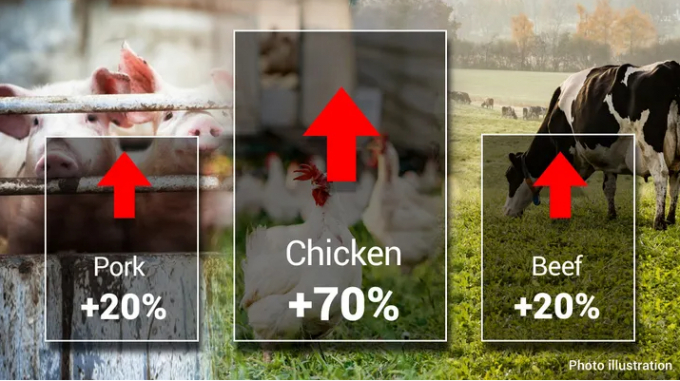November 27, 2025 | 22:28 GMT +7
November 27, 2025 | 22:28 GMT +7
Hotline: 0913.378.918
November 27, 2025 | 22:28 GMT +7
Hotline: 0913.378.918

NOTES: The table shows the number and the share of people who cannot afford a healthy diet, or who are at risk of not being able to afford one if a shock reduces their income by one-third, by region and income group in 2019. The 2019 cost of a healthy diet is taken from FAO et al. (2021). See Annex 1 of the report for methodology and data sources and Annex 3 of the report for the results for the full set of countries.SOURCE: FAO elaboration for the report.
The economic fallout of the COVID-19 pandemic, climate variability and extremes, conflict, and the persistence of hunger and malnutrition have shown us that now is the time for us to build more resilient agrifood systems.
If we don’t, agrifood systems will not be able to ensure food availability to all as well as physical and economic access to nutritious foods that make up healthy diets.
So, how can we protect our agrifood systems from shocks and stresses and better ensure nutritious food is available to all? In other words, how can we make our agrifood systems resilient?
Understanding agrifood systems
First, let’s look at what agrifood systems are. Before food reaches our plates, it travels a long way. It’s every stage of that journey – from harvest to consumption – that makes up our agrifood systems. They involve a set of interlinked activities that encompass farming, processing, transporting, eating and more.
Although often complex and international in scope, agrifood systems have three main components:
From farmers to truck drivers and beyond, agrifood systems involve many actors operating across different components. Shocks or stresses in any of these components can spread rapidly throughout systems and threaten the functioning of supply chains and the food security and nutrition of consumers.
Disaster strikes: How can agrifood systems absorb shocks and stresses?
The COVID-19 pandemic raised concerns that adequate food supplies would not reach consumers as supply chains faced multiple shocks and stresses.
Ensuring agrifood systems could perform well during the pandemic was a key concern, and these experiences have led to increased analysis of these systems. After all, the preservation of agrifood systems helps to ensure food security, nutrition and the livelihoods of millions of people.
The pandemic also created an opportunity to promote further interest in ensuring diversity and connectivity, both key for resilient agrifood systems.
Diversity is essential

A new analysis from Evercore ISI shows pork and beef price inflation could reach as high as 20% year-over-year in the first half of 2022, while chicken breast could reach as high as 70% over last year. Source: FOX Business
Diversity – in production, output markets, import sources and supply chains – was a key resource during the pandemic because it created multiple pathways for absorbing the shock.
Why we need to act now
We know that any challenges to agrifood systems can affect large numbers of people. Currently, 41.9% of the global population are unable to afford a healthy diet. That’s over 3 billion people.
But what if there was a disaster or an economic shock?
An additional 1 billion people around the world are at risk of not affording a healthy diet if a shock caused their incomes to reduce by one-third.
Furthermore, food costs could increase for up to 845 million people if a disruption to critical transport links were to occur.
So, what can be done?
Resilient agrifood systems are key to ensuring that even greater numbers of people do not lose access to healthy diets.
For governments and policymakers, this can be achieved by:
ensuring diversity of food sources (from domestic production, to imports and existing stocks), and of actors in food supply chains;
managing connectivity, such as through the creation of robust food transport networks;
providing a longer-term development perspective that raises incomes;
improving productivity and efficiency to lower the cost of nutritious foods;
supporting livelihoods with gender and nutrition-sensitive social protection programmes.
To ensure the affordability of a healthy diet, either the cost of food must come down, or the incomes of the vulnerable population must increase or be supported through, for example, social protection programmes – or, ideally, both.
In addition, the resilience of rural low-income households can be significantly strengthened through education, non-farm employment and cash transfers.
(FAO.org)

(VAN) A new study reveals how the simultaneous effects of ocean acidification, salinity and loss of oxygen are making the world more fragile.

(VAN) Hopes are growing that the creation of the first 3D turkey gut model could be a turning point in the battle against the virulent blackhead disease.

(VAN) Tyson, America’s biggest meat supplier, plans to shutter one of its largest beef processing plants as the industry continues to struggle with low cattle supplies and political pressure from Washington.

(VAN) New FAO study shows how digital solutions are empowering farmers and fishers to prevent losses and build resilient agrifood systems.

(VAN) Brazil's COP30 presidency pushed through a compromise climate deal on Saturday that would boost finance for poor nations coping with global warming but that omitted any mention of the fossil fuels driving it.

(VAN) Poultry farmers in the UK have been warned that they could face one of the worst winters yet for bird flu.

(VAN) Prices of main-crop paddy have risen sharply, with jasmine rice hitting 16,100 baht per tonne — the highest level in years.